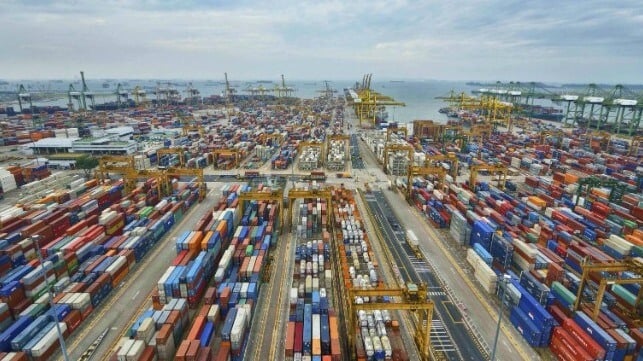Red Sea Diversions Are Causing Port Congestion in Singapore

As shipping lines divert traffic away from the Red Sea to avoid the persistent menace of Houthi rebel attacks, new routes are reshaping the patterns of marine traffic and port calls around the world. Vessels normally assigned to other trades have been diverted to the core Asia-Europe service lane, which is now thousands of miles longer than before because of the need to circumnavigate Africa.
One unexpected outcome has been extra demand for bunkering and transshipment at the already-busy port of Singapore, as ships fuel up for a longer haul and offload the cargo that they would previously have delivered to the Mideast on the way to Suez.
As demand for transshipment rose, Singapore's container volume in the first five months of the year climbed nearly eight percent over the same period in 2023. According to Drewry, Singapore's container terminal utilization rate nearly hit 90 percent in May, a level where productivity often begins to decline because of excess crowding. Drewry director Jayendu Krishna told Bloomberg that boxships are "bunching up" in Singapore and other hubs beause of route and schedule changes, leading to congestion.
According to tracking service Portcast, delays at Singapore have extended up to seven days, and up to 450,000 TEU worth of containerized vessel capacity was waiting to berth at the port as of the end of May. Terminal operator PSA Singapore is reactivating some of the facilities at its older Keppel Terminal in response to the extra demand, and some container carriers are skipping the port altogether in order to keep their schedules on time.
"This year, congestion at Singapore Port is primarily caused by ships returning to Asia off-schedule after longer voyages around the African Cape due to the Red Sea crisis and missed weekly sailings," explained Portcast. "The diversions have caused ships to arrive in Asia unpredictably, exacerbating congestion at Singapore’s port."

that matters most
Get the latest maritime news delivered to your inbox daily.
The disruption in Asian hub ports is helping to support higher container rates, according to Maersk Group. The number-two ocean carrier recently raised its profit outlook for the year, largely because of the effects of congestion and diversion on the supply of container ships.
The Cape of Good Hope diversions have affected about 90 percent of the container ship traffic that once passed through the Red Sea and the Suez Canal. Each diversion adds about $1 million in fuel costs and 1-2 weeks of voyage time, but saves the shipowner up to one percent of the vessel's value in war risk insurance costs. In a new report released Thursday, the U.S. Defense Intelligence Agency said that the Houthi campaign of anti-ship missile strikes has affected the interests of at least 65 nations, according to DIA, and at least 29 major energy and maritime companies have diverted away from the Red Sea because of the risks. The list of affected countries includes Houthi allies and sympathizers, like Iran, Russia and China.
